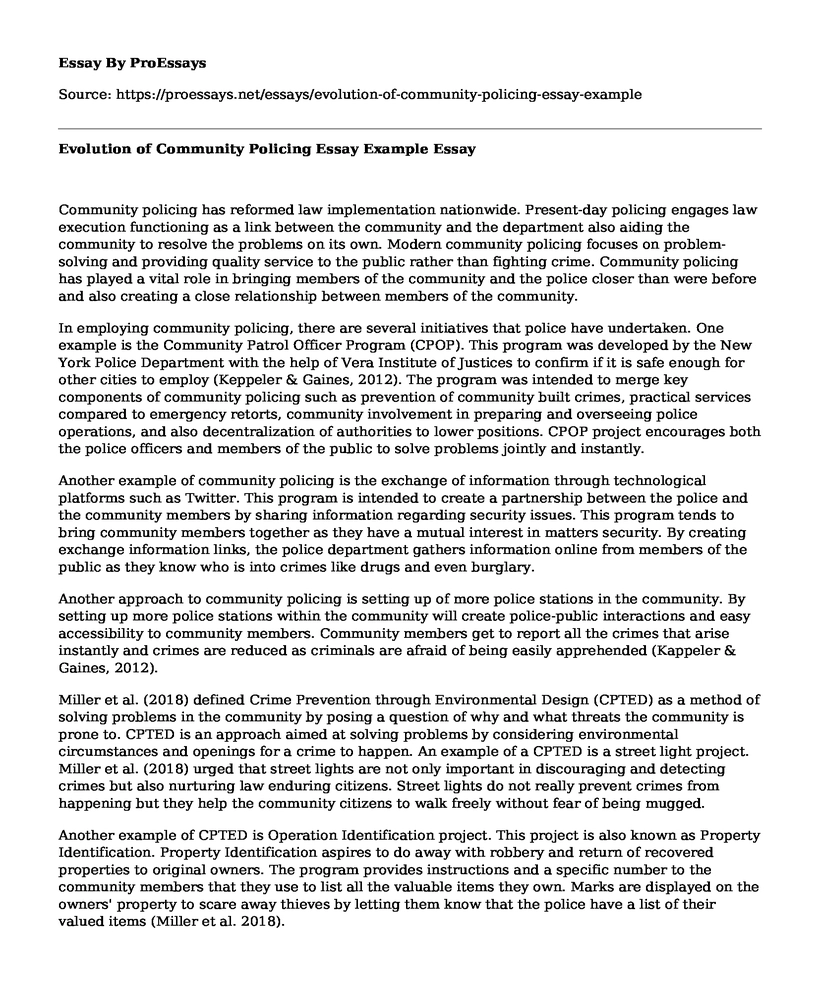Community policing has reformed law implementation nationwide. Present-day policing engages law execution functioning as a link between the community and the department also aiding the community to resolve the problems on its own. Modern community policing focuses on problem-solving and providing quality service to the public rather than fighting crime. Community policing has played a vital role in bringing members of the community and the police closer than were before and also creating a close relationship between members of the community.
In employing community policing, there are several initiatives that police have undertaken. One example is the Community Patrol Officer Program (CPOP). This program was developed by the New York Police Department with the help of Vera Institute of Justices to confirm if it is safe enough for other cities to employ (Keppeler & Gaines, 2012). The program was intended to merge key components of community policing such as prevention of community built crimes, practical services compared to emergency retorts, community involvement in preparing and overseeing police operations, and also decentralization of authorities to lower positions. CPOP project encourages both the police officers and members of the public to solve problems jointly and instantly.
Another example of community policing is the exchange of information through technological platforms such as Twitter. This program is intended to create a partnership between the police and the community members by sharing information regarding security issues. This program tends to bring community members together as they have a mutual interest in matters security. By creating exchange information links, the police department gathers information online from members of the public as they know who is into crimes like drugs and even burglary.
Another approach to community policing is setting up of more police stations in the community. By setting up more police stations within the community will create police-public interactions and easy accessibility to community members. Community members get to report all the crimes that arise instantly and crimes are reduced as criminals are afraid of being easily apprehended (Kappeler & Gaines, 2012).
Miller et al. (2018) defined Crime Prevention through Environmental Design (CPTED) as a method of solving problems in the community by posing a question of why and what threats the community is prone to. CPTED is an approach aimed at solving problems by considering environmental circumstances and openings for a crime to happen. An example of a CPTED is a street light project. Miller et al. (2018) urged that street lights are not only important in discouraging and detecting crimes but also nurturing law enduring citizens. Street lights do not really prevent crimes from happening but they help the community citizens to walk freely without fear of being mugged.
Another example of CPTED is Operation Identification project. This project is also known as Property Identification. Property Identification aspires to do away with robbery and return of recovered properties to original owners. The program provides instructions and a specific number to the community members that they use to list all the valuable items they own. Marks are displayed on the owners' property to scare away thieves by letting them know that the police have a list of their valued items (Miller et al. 2018).
Conclusion
Block Program or citizen crime reporting program is another example of CPTED. This program was designed to organize the citizens in the area as joint help societies and help police to keep an eye in the area. By keeping increased surveillance, minimal crime chances and improves informal communal control, block program has been termed as the backbone of crime prevention in the community. The meetings are held in the homes of one of the public member and discuss issues at risk and also arising in the neighborhood (Miller et al. 2018).
References
Kappeler, V. & Gaines, L. (2012). Community Policing: a Contemporary Perspective. Burlington: Elsevier Science.
Miller, L. (2018). Community policing: partnerships for problem-solving. S.l: Cengage Learning
Cite this page
Evolution of Community Policing Essay Example. (2022, Oct 05). Retrieved from https://proessays.net/essays/evolution-of-community-policing-essay-example
If you are the original author of this essay and no longer wish to have it published on the ProEssays website, please click below to request its removal:
- Criminal Law Story by the Canadian Press
- Case Investigation of Jack the Ripper: Research Paper Example
- Expository Essay on Social Justice and Diversity in the US
- Essay Example on Andrade's 25yr Life Sentence for Petty Theft: Injustice?
- Essay Sample on Human Rights Violations: A Global Malpractice in Health Care
- Essay Example on Amelia Dyer: Notorious Female Serial Killer of 1800s Baby Farming
- Plan of Action to Maintain Law & Order: A Global Perspective - Essay Sample







